Back to top: Overview
Physiognomy
Physiognomy as used in unit J5 is defined in the Mozan Sitewide book. Our initial plans for excavation were based on previous excavations of the EDIII revetment wall to the north that had traced its extent to a turn to the west. (See t4). In addition a geomagnetic servey by a German team revealed a large structure farther to the west that we assumed might be a dedicated access to the temple from the Akkadian palace to the south.
As detailed in the following sections, our evolving strategy was guided by the the unique nature of the excavated structures and by ceramics analysis in real time. For example, early in the excavation we found that the wall section at the turn that we thought was EDIII was Mittani and connected to a small stairway that turned out to be a new BA temple entrance.
Back to top: Overview
Assumptions
On the basis of our initial excavations on the temple complex, it was assumed that its general form was symmetrical and that it formed an oval, walled in stone and sitting above an open plaza, with the temple at the center and possibly with several points of access. Based on the excavations of the last two seasons and on an extensive geophysical survey, we have modified our hypothesis. Among other things, the formal boundary of the temple complex now seems to be confined to the southwest, while the eastern part may well end at the staircase. Excavations in unit J1 in the MZ19 season (2006-Q) revealed that, at its western extremity, the revetment wall made a sharp turn to the north. Furthermore the wall in that vicinity seemed to comprise a double line of stones, separated by about 5 meters with possibly a paving of large flat stones between them.
Excavations in J5 were intended:
- to follow this wall to the north, to determine the nature of the relationship of the components of that part of the wall system,
- to determine the physical links, if any, between the temple complex and the Tupkish palace, and
- to verify the geomagnetic survey data which showed that there might be a northern boundary to the plaza in this general location, possibly through a link with a substantial building associated with the palace.
Back to top: Overview
Initial strategy (2009)
To accomplish these goals we decided to incorporate and build upon that portion of unit J1 that contains the double wall.
- First, we will clean and document the previously excavated portion of the revetment wall in J5.
- Next, we will open two loci, k23 and k24, north of the west face of the outer of the two lines of stone. There, at a depth of about 150cm below the surface we expect to be able to follow this face which runs roughly north northwest. The geophysical survey indicates the presence of a structure to the west within the range of the new loci. If we find the turn we will follow it to the west with additional loci in that direction.
- In order to define the nature of the wall system as it turns north we will remove some isolated pillars of soil which partially cover it in the portion previously exposed as a part of the J1 excavation.
- If necessary to further explore the construction, we will open a second line of loci running north and located to the east of k23 and k24.
In order to ensure the quality of the recording system, we will station an experienced assistant in the house on a rotating basis to process objects and enter and process data and photographs as they are recorded in the field.
Back to top: Overview
Significant insights
Back to top: Overview
West monumental stone staircase and associated structures
The discovery of a second monumental staircase on the western end of the temple complex altered our ideas on the importance of ceremonial structures late into the Mittani period.
(1) Previous excavations in J2 and J3 indicated that as accumulations filled the plaza and covered the revetment wall, memory stones and brick columns were used to preserve the functional identity of the eastern staircase and wall system.
(2) In time, at the west end of the EDIII revetment wall, the Mittani builders decided to fashion, on a reduced scale, a mirror image of the wall, staircase and apron.
(3) With the discovery of the western staircase we decided to fully expose and preserve this Mittani phase even though it meant that we may not be able to excavate earlier phases of the wall system below it.
|
|
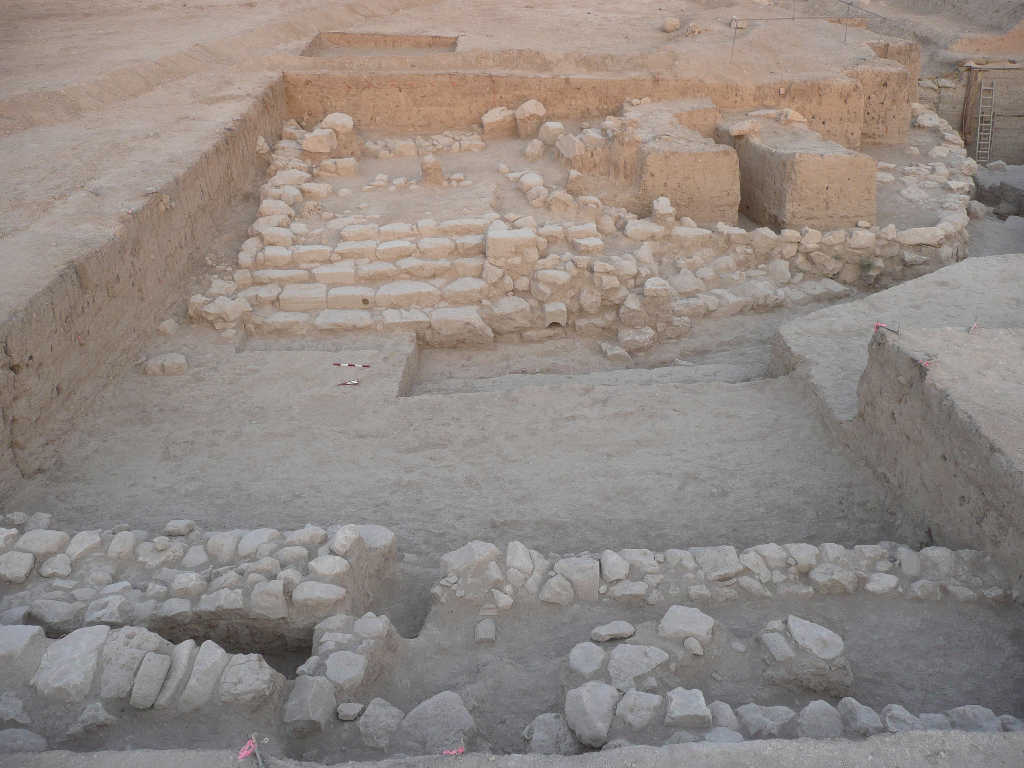
|
Back to top: Overview
Revetment wall and its escarpments
At the end of the 2008 excavation season we believed that there were three revetment walls:
(1) A large wall built of rough stones and dated to the Early Dynastic period in J1, extended west well into J5. A single baqaya escarpment was visible.
(2) A late Mittani wall added onto the end of the ED wall and extending north.
(3) A wall of cut stones extending northwest from under the Mittani wall and having a mud escarpment. We did not know when it was built, but it has the same top elevation as the rough stone wall mentioned above..
This situation was clarified by the 2009 excavations:
(1) The EDIII wall had two escarpments; a slightly later one of baqaya, and an earlier one of rows of large, cut stones. Both were dated to EDIII.
(2) The Mittani structures and accumulations were directly atop the ones from EDIII. There was no material from intermediate phases.
(3) The first escarpment followed the east-west revetment wall and turned, without a break, northwest to follow the cut stone wall. Thus we know that the cut stone wall was a part of the EDIII wall system.
(4) The rough stone and cut stone EDIII wall rested on an earlier wall which aligns with a wall segment in J1 to the east that is dated to the Late Chalcolithic period.
(5) Most importantly, these EDIII structures are relatively close to the surface of the temple mound, which indicates that a substatial earlier settlement lies directly below.
|
|
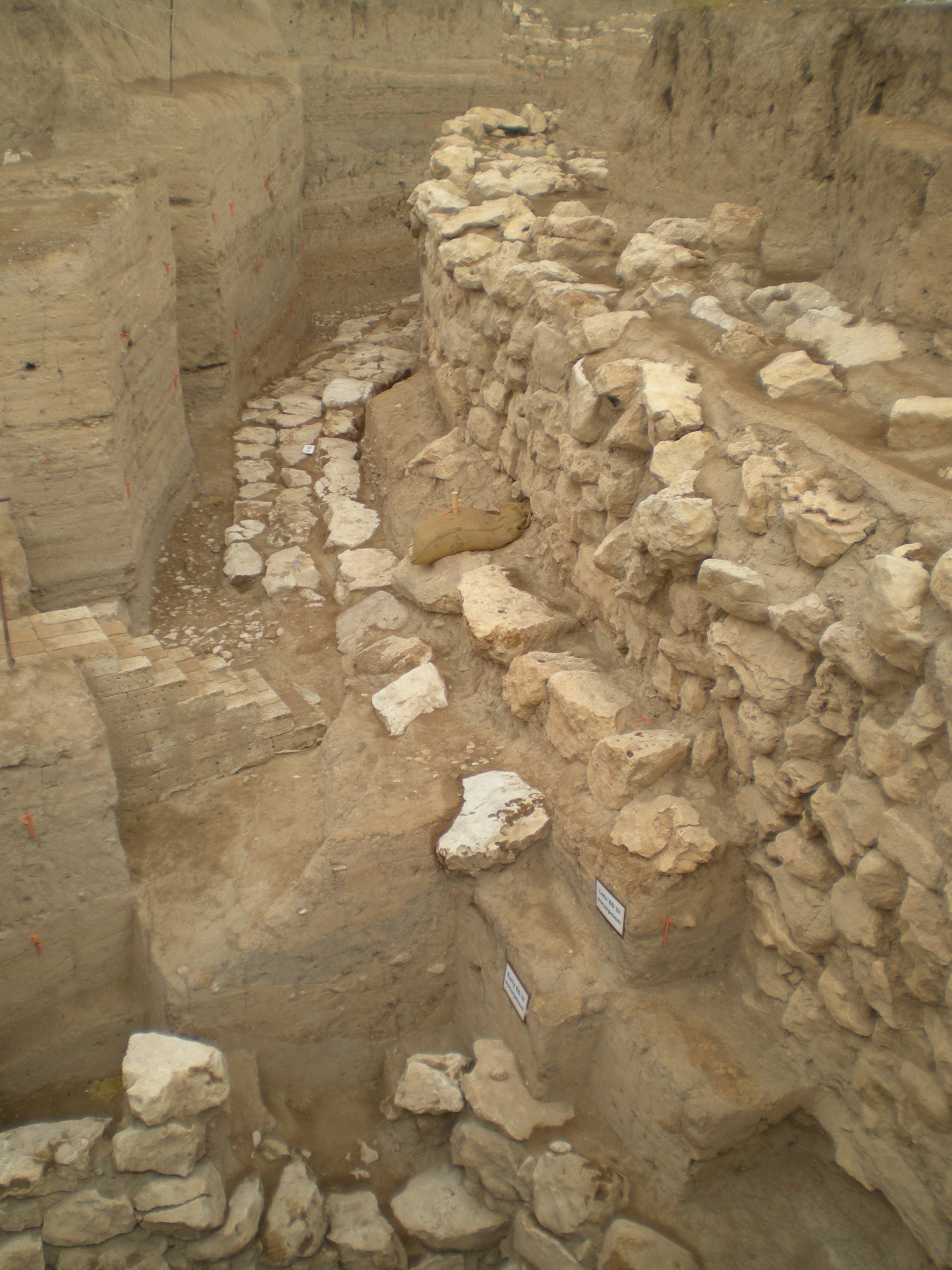
|
Back to top: Overview
Control of water flow
Excavations in this unit and in J1 have shown that damage caused by water flowing along the outside of the various revetment wall systems has been substantial and continuing:
(1) The second baqaya escarpment to the main EDIII revetment wall was built atop the first stone escarpment soon after it was built to better control the flow of water which had broken into the plaza.
(2) Early in the Mittani westward construction two complex water control structures were built to protect the EDIII walls: one of stepped large stones and the other a brick dam with a pebble holding pond.
(3) Late in the Mittani period, a simple weir was built to divert water around the Mittani revetment wall.
(4) The discovery of a pebble floor which abuts the stone first escarpment to the south and west suggests that there are substantial structures just beyond which served to channel the water runoff along the face of the revetment walls.
|
|
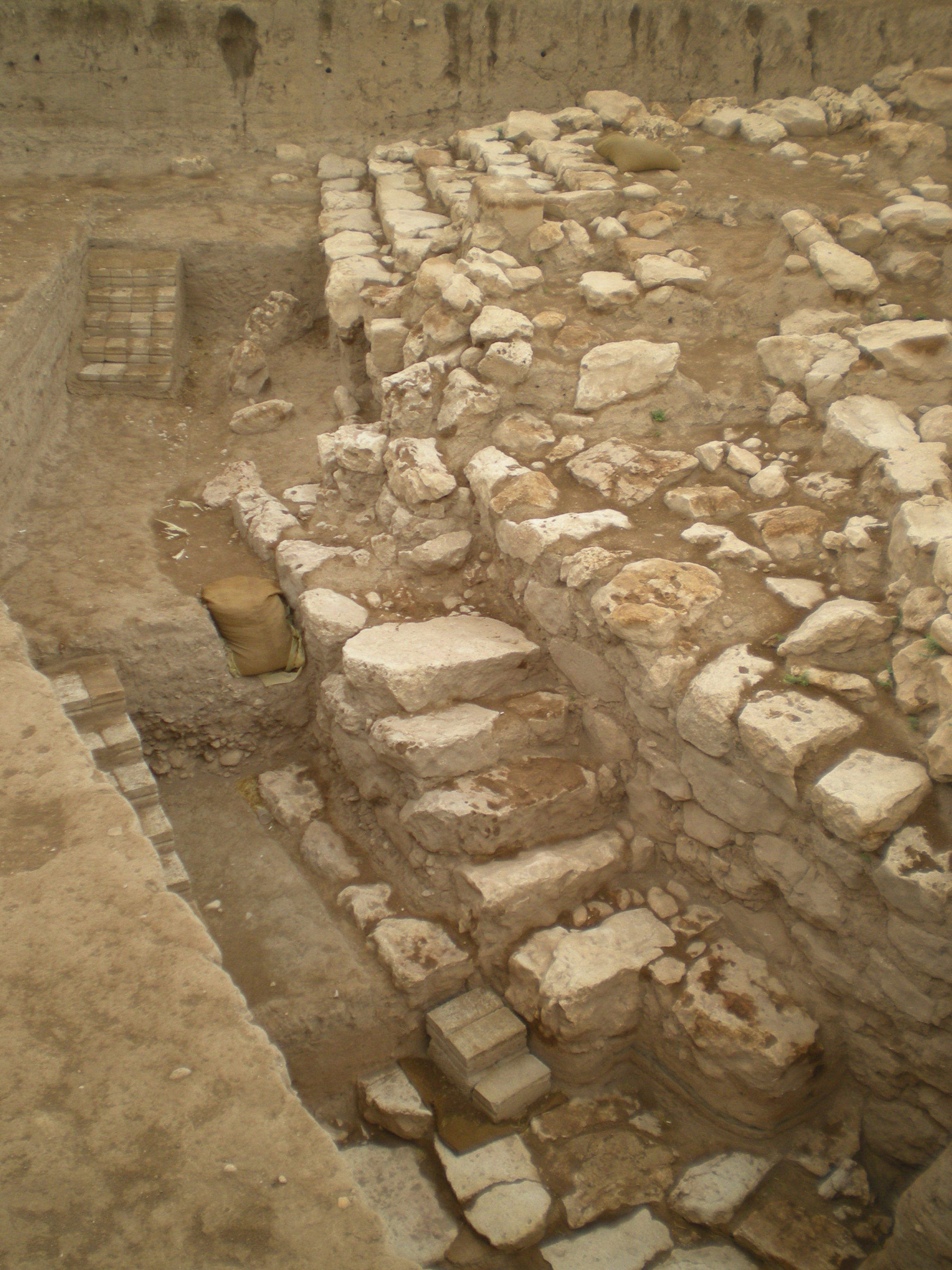
|
Back to top: Overview
Impact on strategy
Now that we understand that Mittani structures were built directly atop the EDIII walls and escarpments, we can explore quickly the northern extensions of the early walls. Perhaps most intriguing is that the water protection systems and the pebble pavement which abuts the early walls indicate that there are a series of EDIII and Mittani structures to the North, which for a thousand years channeled flood waters between them. In the future, it will be important to explore to the north and to the west of the part of the revetment wall built of cut stones to find these structures.
Also, we will look for a place near the outside of the EDIII walls where we can sink a test trench to determine the nature and building dates of earlier structures underneath.
Back to top: Overview
Location
Unit J5 is adjacent to unit J1 to the east (from which it was spun off and with which it shares the stratigraphy) and A20 to the west.
J1 was initiated to determine the nature and extent of the revetment wall, its escarpments and its associated plaza to the south. When explorations to the west of the exposed plaza revealed that the east-west revetment wall system was unexpectedly complex as it turned to the north, J5 was created to devote ample rescources to the investigation.
Further to the west, A20 was a unit created to explore the transition between the Mittani residential areas in A18 and the plaza/revetment wall complex.
A20 (initially A19) was started at the sameJ time as J5, while J1 was started in 2003.
|
|
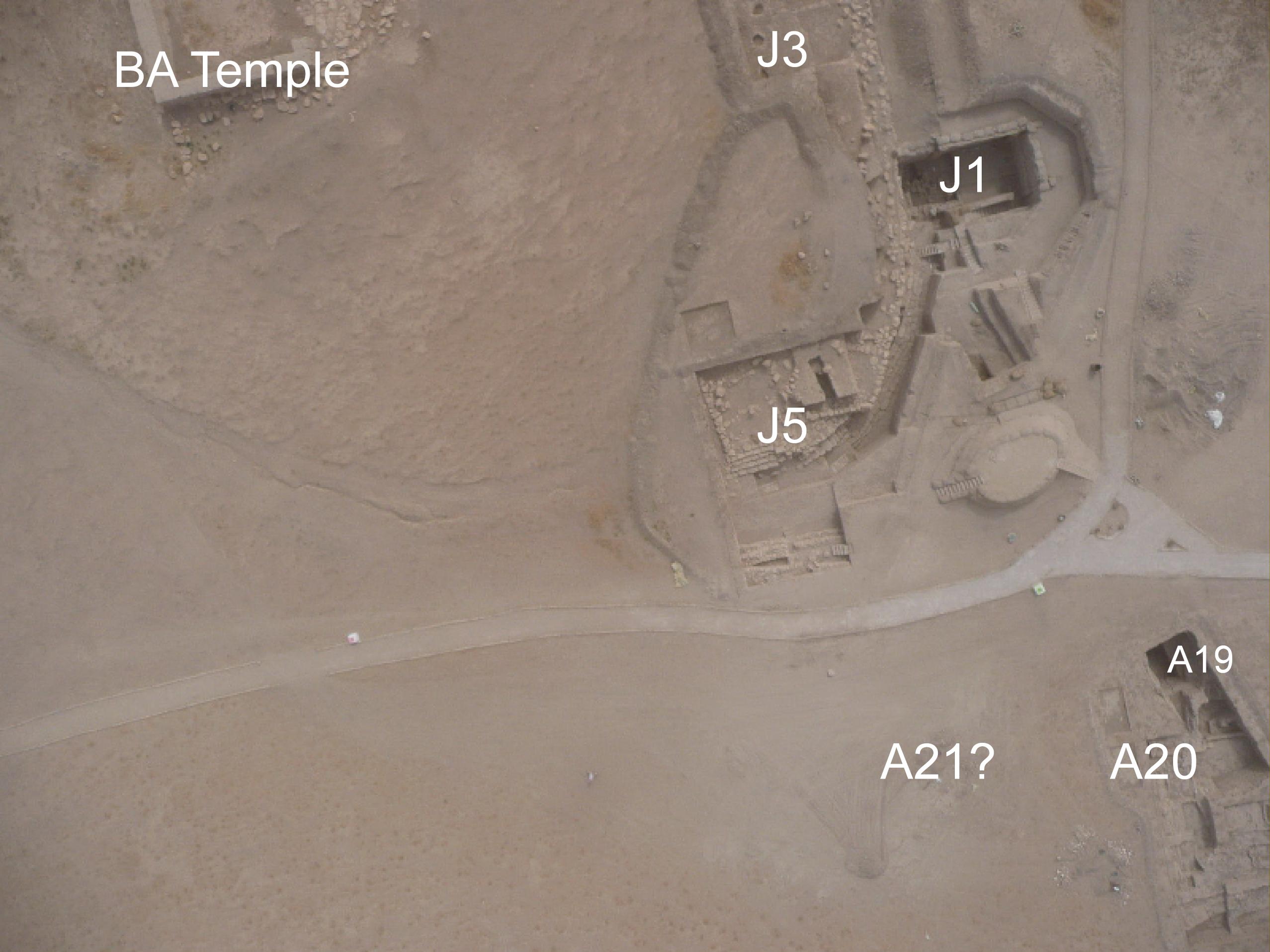
|
Back to top: Overview
Phases
Phase 2h. The main revetment wall is built upon an earlier cut stone wall, tentatively dated to the Late Chalcolithic period by alignment with a similar wall in a similar location in J1. So far no other LC deposits or structures have been excavated in J5.
Phase 3m. All of the stone construction in the eastern part of the unit (revetment wall and its stone escarpment) were built in the Early Dynastic III period.
Phase 3n-3s. In the latter part the EDIII period, these earlier structures were used and modified with the addition of a second, layered baqaya escarpment.
Phase 4 through Phase 6. There is no evidence of construction or use during these periods, even though Urkesh was a significant city during this time period. This is probably due to the fact that the wall and its protection systems were performing their functions and that this part of the temple mound was isolated and used only for sacred functions and always kept clean.
Phase 7a-7e. Early Mittani efforts to control damage from flowing water.
Phase 7g-7m Western retrenchment, use and rebuilding during the middle and late Mittani periods.
Phase 8m. Limited occupation, but no known structures, during the Middle Assyrian period.
Phase 8r-9c. Isolated late period installations.
|
|
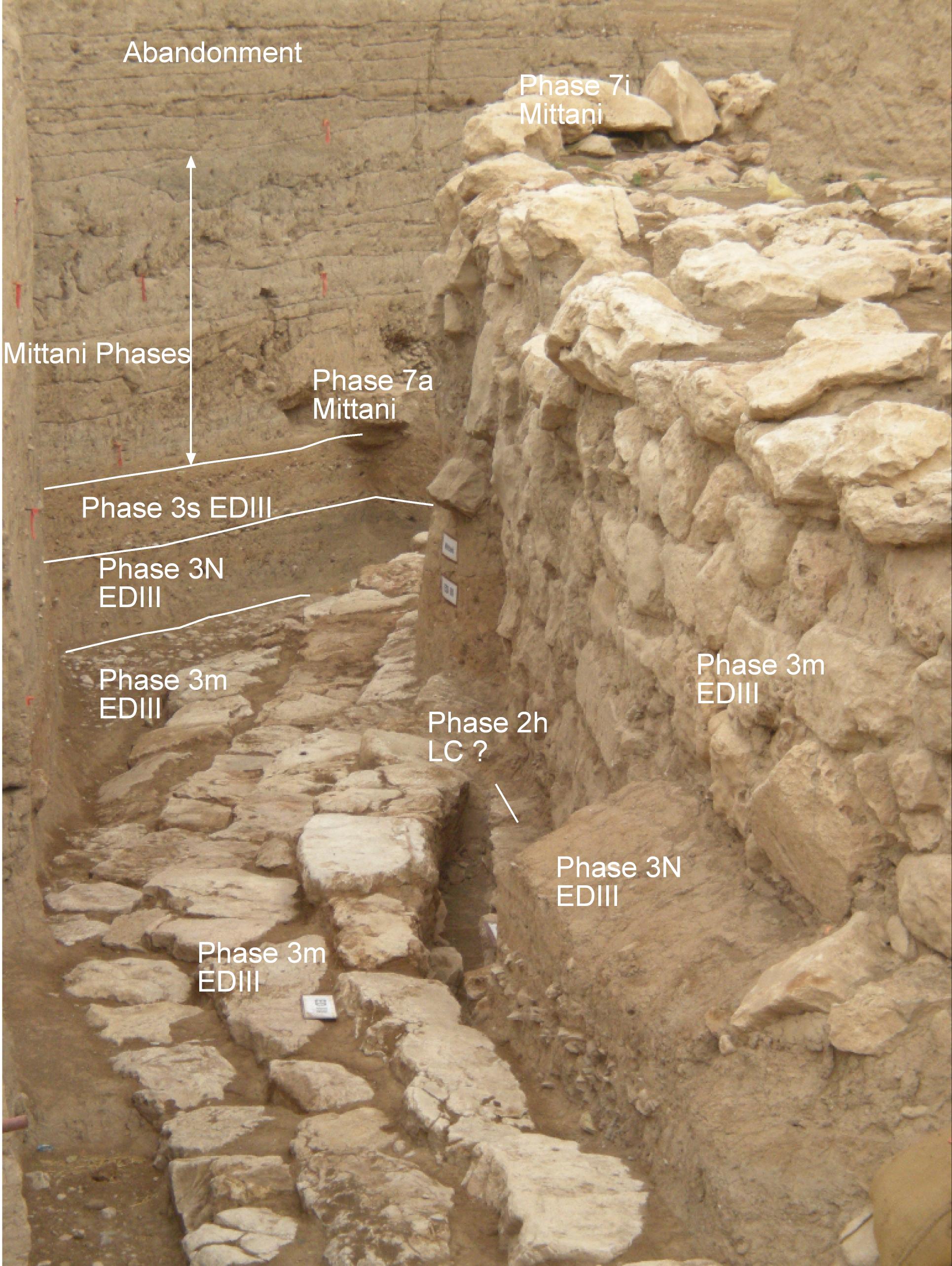
|
Back to top: Overview
General statistics
| approximate cubic meters
|
300
|
| total number of features
|
293
|
| total number of items
|
61
|
| total number of q-lots
|
498
|
| total number of sherds
|
2,809
|
| total number of output files
|
9,205
|
| total number of records
|
1,144,184
|
| total number of hyperlinks
|
509,186
|
| total number of photographs
|
1,459
|
| total number of drawings
|
51
|
| total file size (with low resolution graphic files)
|
73.4 MB
|
Back to top: Overview